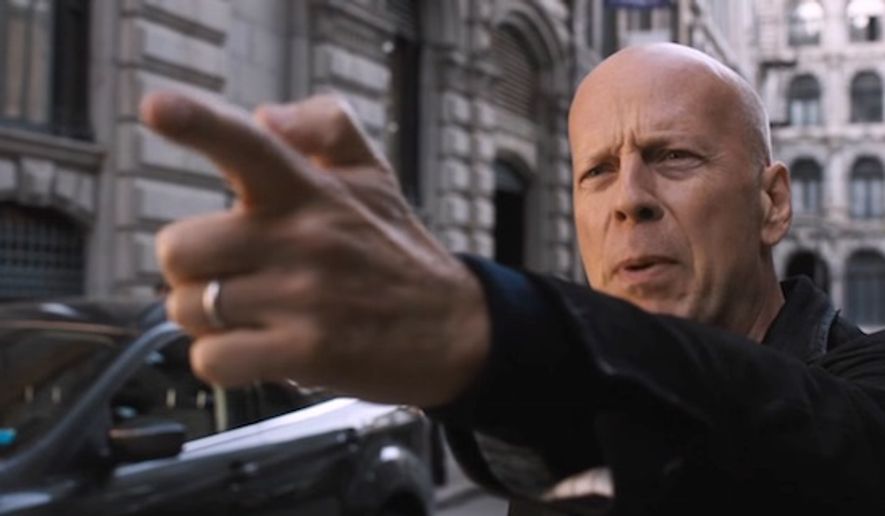“The only way to stop a bad guy with a gun is with a good guy with a gun.”
— Wayne LaPierre, CEO of the National Rifle Association
Enter Dr. Paul Kersey, devoted family man-turned-ruthless vigilante in “Death Wish.”
Director Eli Roth (“Hostel”) reboots the classic 1974 revenge drama with Bruce Willis taking on the lead role embodied by the late Charles Bronson in the original “Death Wish” and its four — yes, four — sequels.
With a shift in setting from the mean streets of 1974 New York City to the meaner streets of 2017 Chicago, Dr. Kersey dons a hoodie and vows to take down the thugs who murdered his wife (Elisabeth Shue) and raped his daughter (Camila Morrone).
This $30 million remake opened Friday amid calls for gun control in the wake of a school shooting, ruminations over street brawls between white supremacists and antifa militants, debate over the Black Lives Matter movement — and focus on the Trump administration’s position on each of these issues.
Could there be a better — or worse — time for a new “Death Wish?”
When the film’s trailer debuted last year, it evoked cries of “fascism” and worse from select film scribes. Britain’s Guardian newspaper greeted the trailer by dubbing it an “alt-right fantasy.”
Such reactions aren’t new for the violent spectacle that is “Death Wish,” which the late Roger Ebert dubbed “propaganda for private gun ownership” in 1974.
But veteran comic book writer Chuck Dixon says that calling the franchise “fascist” doesn’t make sense.
“It’s one guy acting alone. It’s the opposite of fascist,” says Mr. Dixon, whose newest book “Levon’s War: Levon Cade Part 5” extends the author’s own vigilante saga.
Mr. Dixon also discounts critics decrying Mr. Willis’ character for donning a hoodie in the trailer. Some connected the fashion choice to Trayvon Martin, the unarmed black teen who was fatally shot by neighborhood watch leader George Zimmerman in Florida in 2012. Mr. Zimmerman, who testified that Martin’s hoodie made him suspicious of the youth, was acquitted of second degree murder and manslaughter charges.
“People are looking for things to be sensitive about. Everyone wears hoodies. From a writer’s standpoint, it’s a natural disguise in an urban environment,” the comic book writer says.
The new film changes the original setting from a crime-ridden Big Apple to Chicago, currently awash with gun violence. Yet the “Death Wish” remake stalled for years. At one time Sylvester Stallone was attached to the vehicle.
One possible reason for the franchise’s delayed reboot? The vigilante template doesn’t grab the zeitgeist like it did during Bronson’s first film, according to National Review’s Jim Geraghty.
“Statistically, the average moviegoer is less likely to have experienced something like [what the Kerseys endure], and it’s less of a button that filmmakers can push to get an audience to feel the tension and fear of the characters on screen,” Mr. Geraghty says.
Crime statistics nationwide are down despite high-profile massacres like this month’s school shooting in Parkland, Florida, and last year’s mass assault in Las Vegas that left 58 people dead. Back in the early 1970s, fear of crime left audiences eager for Bronson’s iconic character.
Mr. Geraghty points to another reason for the vigilante film’s decline — the modern superhero craze. These larger-than-life characters also take down criminals on their own terms.
“The Punisher, Rorschach from ’Watchmen’ and the Crow are some that come to mind that really straddle the genre line. You could probably argue the first half of ’Batman Begins’ fits it, too,” says Mr. Geraghty, who co-hosts the pop culture podcast “The Jim and Mickey Show.”
Superheroes and vigilantes share something else in common. Their aim is always true, he says.
“[A superhero] never beats up or shoots the wrong guy and never accidentally shoots an innocent bystander,” Mr. Geraghty says. “He can always eventually find the criminal kingpin’s hangout. He can save the hostages. He never crosses the moral event horizon and starts killing people who we think don’t deserve it.”
Jon Gabriel, editor in chief of the center-right site Ricochet.com, predicts that film critics are waiting to pounce on the new “Death Wish.” Social media users may follow.
“With the school shooting recently and the anti-gun perspective dominating the media, it’s going to be a pretty ugly reaction regardless of the content,” Mr. Gabriel says. “The media is primed to be hostile to it.”
It doesn’t help that one of Mr. Roth’s recent films, “Green Inferno,” served up social justice warriors as the main course for the film’s cannibal villains.
Portraying Paul Kersey as a white man, again, also will draw some complaints, Mr. Gabriel says.
That chorus began with the trailer’s release. Collider.com described the teaser as a “white knight fantasy where a white guy gets to be a famous hero by killing off criminals.”
One note: The villains targeted in the trailer represent a diverse array of thugs.
One discussion that may spring from the film touches on a theme we see in one tragic shooting after another: Institutions fail, leaving people to their own devices.
“We are all our first responders,” Mr. Gabriel says.
Mr. Dixon says knee jerk reactions to both the film’s trailer and reimagined story reveal an issue plaguing our social media age.
“We demand too much of our casual pop culture offerings. It’s escapist fiction … you’re escaping into the fantasy of a guy seeking justice on its own terms,” he says.




Please read our comment policy before commenting.